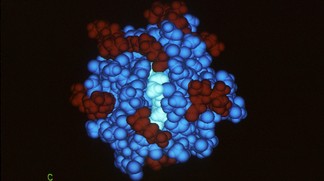May 13 2013
3D structures of biological molecules like proteins directly affect the way they behave in our bodies. EPFL scientists have developed a new infrared-UV laser method to more accurately determine the structure of proteins containing thousands of atoms.
 The 3D structure of cytochrome C (adapted from Wikimedia Commons)
The 3D structure of cytochrome C (adapted from Wikimedia Commons)
Biological molecules like proteins contain thousands of atoms that form extremely complex 3D structures. Being able to identify such structures is important because they directly affect how a molecule behaves in cells, and can often make the difference between life and death; for example, mad cow disease is caused by the misfolded version of an otherwise harmless prion protein. Determining 3D structures can be challenging, because biological molecules can be made up of the same atoms connected in the same order, but have radically different structures and therefore radically different effects. In a publication that made the cover of Angewandte Chemie, EPFL scientists used a new method based on infrared and UV lasers to more accurately determine the structure of biological molecules.
Proteins and peptides tend to have extremely complex three-dimensional structures. The problem is complicated by the fact that they often exist as isomers, i.e. they have the same sequence of atoms but different 3D structures. That means that simply knowing what a molecule is made of is not enough to understand what it looks like in three-dimensional space. More information is needed, and that comes in the form of molecular “fingerprints” – characteristics of a molecule that reflect its 3D structure. Clearly, two isomers would not share the same structural characteristics, meaning that more fingerprints would make it easier to distinguish them.
Working out the structure of biological molecules begins by making several theoretical predictions of what a molecule would look like, and then matching them to experimental data. Currently, one of the new and promising techniques providing such data is Cold Ion Laser Spectroscopy, which has been developed for over a decade at EPFL’s Laboratory of Molecular Physical Chemistry (LCPM). Molecules are ionized, cooled close to absolute zero and then shot with infrared and UV lasers at different energies, each producing a different number of molecular fragments. These fragments are then measured by a mass spectrometer, which tells scientists about energy levels within the molecule.
EPFL scientists have now extended this approach to include a new fingerprint, greatly increasing the accuracy of structure determination. Oleg Boyarkine’s team at LCPM discovered the way to measure precisely how much light a molecule can absorb, which is another fingerprint of its 3D structure. The atoms in a molecule are not at rest; rather, they vibrate at frequencies that depend on how the atoms are structured in space. As there are three vibrational frequencies for every atom, large biological molecules like proteins can have hundreds to thousands of frequencies that together provide a unique fingerprint of the molecule’s 3D structure.
By analyzing how Cold Ion Laser Spectroscopy works, the scientists came to the idea of how to measure what is called the absolute absorption intensity for each vibration of a molecule, creating a whole new fingerprint to work with. This makes it possible to identify the molecule’s 3D structure with more certainty, because it is unlikely that two isomers will have the same vibrational frequency and light absorption pattern at the same time.
The researchers first tested their new approach with a known antibiotic molecule made of 176 atoms. When that proved successful, they pushed the boundaries of spectroscopy and recorded the first ever “vibrational spectrum” for a protein called cytochrome c, which is critical in processing oxygen in our cells. Their breakthrough two-fingerprint approach advances structural chemistry and can allow scientists to faster and more accurately determine the structure of large biomolecules like polypeptides and proteins, which can have tremendous implications for biotechnology, clinical diagnostics, epidemiology (e.g. prion diseases), molecular biology and genetics, and wider biological endeavors.